Gram pod borer
Symptoms of damage
- Defoliation in early stages
- Larva’s head alone thrust inside the pods and the rest of the body hanging out.
- Pods with round holes
Identification of pest
Scientific Name - Helicoverpa armigera
- Eggs : Spherical in shape and creamy white in colour, laid singly
Larva : Shows colour variation from greenish to brown. Green with dark brown grey lines laterally on the body with lateral white lines and also has dark and pale bands.
Pupa : Brown in colour, occurs in soil, leaf, pod and crop debris
Adult : Light pale brownish yellow stout moth. Fore wing grey to pale brown with V shaped speck.Hind wings are pale smoky white with a broad blackish outer margin.
|
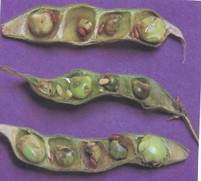 |
| Larva feeding the pod |
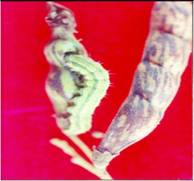 |
| Damaged pod |
|
| Top |
Spotted pod borer
Symptom of Damage
- Defoliation in early stages
- Larva’s head alone thrust inside the pods and the rest of the body hanging out.
- Pods with round holes
Identification of pest
Scientific Name - Maruca testulalis
- Larva - Greenish white with brown head. It has two pairs of dark spots on the back of each segment
- Adult - Forewings- light brown colour with white markings; Hindwings – white colour with brown markings at the lateral edge
|
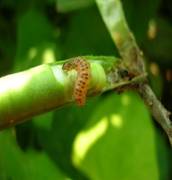 |
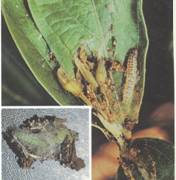 |
|
| Top |
Spiny pod borer
Symptom of Damage
- Dropping of flowers and young pods
- Older pods marked with a brown spot where a larvae has entered
Identification of pest
Scientific Name - Etiella zinckenella
- Larval
- greenish initially, turns pink before pupation.
- It has 5 black spots on the prothorax
- Adult
- Brownish grey moth
- Prothorax – orange in colour
- Fore wing - has a white stripe along the anterior margin
|
|
| |
|
| Top |
Blue butterfly
Symptom of Damage
- Buds, flowers and young pods with boreholes
- Presence of slug like caterpillar.
- Honey dew secretion with black ant movements
Identification of pest
Scientific Name - Lampides boeticus
- Larva – It is flat and slightly rounded; Pale green with a rough skin.
- Adult - moth is greyish blue with prominent black spots in the hind wings and a long tail; Ventral side of wings with numerous stripes and brown spots
|
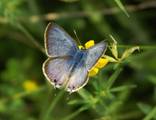 |
|
| Top |
Grass blue butterfly
Symptoms of damage
- Buds, flowers and young pods with boreholes and presence of slug like caterpillar.
- Larval entry hole on the pod is plugged with excreta.
Identification of the pest
Scientific Name - Aphis craccivora
- Larva - pale green or yellow with a red line and short black hairs on the body.
- Adult - butterfly is blue, medium sized with 5 black spots in the hind wings and two black spots in the inner margin.
Management Strategies
- Deep summer ploughing in 2-3 years to eliminate quiescent pupa.
- Early sowing, short duration varieties.
- Avoid closer plant spacing.
- Grow tall sorghum as comparison crop to serve as biological bird perches
- Collect and destroy larvae and adults to the extent possible
- Install pheromone traps at a distance of 50 m @ 5 traps/ha for each insect pest.
- Install Bird perches @ 50/ha.
- Setting of light traps (1 light trap/5 acre) to kill moth population.
- Control is achieved by releasing of Trichogramma chlionis at weekly intervals @1.5 lakh/ha/ week for four times.
- Conserve green lacewing, predatory stink bugs, spider, ants
- Bt @ 600 g, neem oil/ pungum oil 80 EC @ 2ml/lit
|
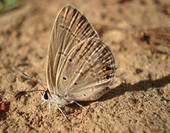 |
|
| Top |
| Sucking pests |
Bean Aphids
Symptoms of damage
- Leaves, inflorescence stalk and young pods covered with dark coloured aphids
- Honey dew secretion with black ant movements
Identification of the pest
Scientific Name - Aphis craccivora
- Nymphs and Adult – dark coloured with cornicles in the abdomen
|
|
|
| Top |
Leaf hopper
Symptoms of damage
- Leave mottled and yellowish in colour
- Green colour insects found under surface of leaves
Identification of the pest
Scientific Name - Empoasca kerri
- Adult – elongate, active, wedge shape, green insects
|
|
|
| Top |
Pod bugs
Symptoms of damage
- Pods with black spots
- Shedding of green pods
- Poorly filled pods with shriveled grains inside
Identification of the pest
Scientific Name - Riptortus pedestris
- Brownish black and hemispherical
- Nymphs : Resemble dark brown ants
|
|
|
| Top |
Lab lab bug or Stink bug
Symptoms of damage
- Cluster on the plant parts and suck the sap
Identification of the pest
Scientific Name - Coptosoma cribraria
- Nymphs and Adult - Sub globular, oval and greenish shield bug
- It has a characteristic buggy odour
|
|
|
| Top |
Whitefly
Symptoms of damage
- Leave mottled and yellowish in colour
- Vector of yellow mosaic virus
Identification of the pest
Scientific Name - Bemisia tabaci
- Adults -are small, yellow bodied insects with white wings which are densely covered with a waxy powder.
- Nymphs and pupae -are black and round or oval. Pupae have marginal bristles
Management Strategies
- Shaking the infested plants over the vessels of oil and water or oily cloth gives most effective
|
|
|
| Top |
| Flower feeder |
Blister beetle
Symptoms of damage
- The adult feeds voraciously on buds and flowers
Identification of the pest
Scientific Name - Mylabris phalerata
- Eggs - are light yellowish in colour and cylindrical in shape
- Larvae - Young grubs are white in colour
- Adult – Elytra are black in colour with a round orange spot and two transverse wavy orange bands across the wings
Management Strategies
- Manual collection or collection with insect net and killing of adults in kerosenized water appears to be the only possible solution.
|
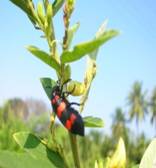 |
|
| Top |